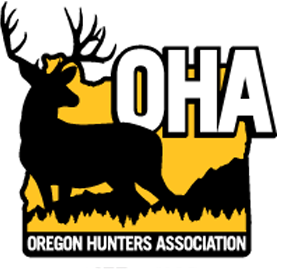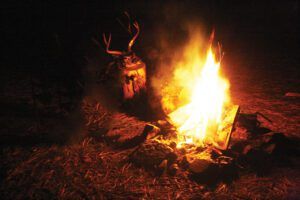Sparks Against The Sky
OHA toasts 40 years of fighting for our hunting heritage from the breaks of the Snake to the breakers of the Pacific.
By Gary Lewis
It was a snowy November evening and a group of hunters sat around a fire while the sparks from the tamarack crackled against the nighttime sky. At first, they talked about elk and then they talked rifles, but the topics soon turned to bad legislation in Salem and cutting back on antlerless deer seasons, privatization of public lands, timber and mining projects, and the loss of wildlife habitat.
Someone asked, “What are we going to do about it?” and the idea was formed to create an association of Oregon hunters. That next year in 1983, a board of directors was formed that included Brian Adams of Spray, Dan Boone of Bend, Lee Carver of Prineville, Pat Johnsrud of Drain, Jerry Norris of Klamath Falls, George Price of Portland, and Max Walker of Enterprise.
A membership drive was kicked into gear with a large number of people who believed enough in the mission to sign up as life members of the fledgling organization. Ed Park was hired as executive editor of The Oregon Hunter magazine, Neil Rodgers was managing editor, and Mark Bagett was staff photographer and northwest field editor. The first issue was published June 1983.
Said one Prineville member in 1983, “Oregon hunters can no longer sit back and expect hunting opportunities like they’ve experienced in the past to be laid in their laps every year. We have all got to fight for our hunting every year.”
AN EARLY IMPACT
One of the early projects was a quick response to the brutal winter of 1983-84. Baker and Union counties were hit hard by blankets of deep snow followed by freezing rain, which sealed the snow with a layer of ice two inches thick. The ice crust lasted for two months and a whole crop of fawns starved to death, along with a lot of elk calves. Wallowa, Harney and Malheur counties also suffered substantial losses of deer, elk, antelope and game birds. ODFW Baker biologist Dick Humphreys called it a “killer winter.” ODFW quickly exhausted their budget for wildlife feeding.
Spearheaded by OHA’s Union County chapter, a special fund was set up to accept donations to go directly into winter feeding efforts, and OHA volunteers quickly organized to help with feeding efforts. Up to 10 OHA members per day helped ODFW personnel feed deer, elk and game birds. The OHA fund helped feed 7,100 deer and 2,400 elk daily in the form of 43 tons of specially formulated deer pellets. ODFW biologist Mark Henjum of La Grande said, “Whenever wildlife is in trouble, the first ones to get involved are always the hunters.”
OHA TODAY
In recent years, OHA has been instrumental in helping ODFW develop its predator management plans, working to keep the Elliott State Forest and other lands in public hands, passing laws to increase penalties for poaching, and preserving traditional public hunting access in the Owyhee, the Ochocos, the Cascades and monuments in southwest Oregon.
Recently OHA allocated $10,000 to ODFW for a wildlife forage enhancement project at Clarks Fork near Butte Falls. OHA’s contribution allowed ODFW to receive a 3-to-1 match in funds from the Pittman-Robertson fund.
To bolster the anti-poaching effort, the OHA grant committee awarded $2,750 to the Oregon State Police to help purchase special trail cameras that can capture license plates on moving vehicles after dark. This will help with efforts in the Mid-Columbia region where trespassing and illegal take of mule deer, bears and turkeys has reached chronic levels.
Working with partners and state agencies, OHA has been instrumental in reducing vehicle and deer collisions through donations to wildlife underpasses and strategic fencing.
To battle the threat of chronic wasting disease, OHA has worked with ODFW to encourage check stations on well-traveled highways.
In Central Oregon, efforts to protect mule deer winter range paid off with a conservation easement in critical habitat.
Last August, our state board sent a letter to the ODFW Commission, regarding implementation of a wolf depredation hunt to help landowners deal with wolves predating on livestock. Thanks in part to OHA’s efforts, Phase III of Oregon’s current wolf conservation and management plan includes using controlled hunting, and we believe the benchmarks have been met to allow for implementation of the plan.
Commission approval is required and will occur in a separate rulemaking process, according to Commission chair Mary Wahl. In her response, she indicated the Commission will review the plan in 2023, and controlled hunting will be one topic in the review process.
On the ground in Oregon, OHA conservation coordinator Tyler Dungannon recently led a new project to restore mule deer habitat in the recently burned Interstate Unit where half a million acres burned in 2021. In concert with many partners and the Warner Creek Correctional Facility, sagebrush and bitterbrush plugs were raised in the prison and planted in critical mule deer range.
A SHARED VISION
Today, OHA is an organization of 26 chapters and 10,000 conservation-minded hunters and publishes an award-winning magazine and Oregon Hunter’s calendar. OHA employs a year-round policy director, conservation staff and field director to advocate for our membership’s goals and support our positions on key issues.
Every now and then you meet a person whose eyes sparkle when they talk about their last hunt or the next one. It drives them. It fuels them. People like Amy Patrick, our policy director and Steve Hagan, a long-term board member now serving as OHA president.
Patrick believes our strength as an organization lies in our laser focus on the mission statement, allocating staff and volunteer time to those things that line up with our core values. An advocate for hunters’ rights and for science-based wildlife management, she filled her first deer tag in October 2022, and took her trophy home to process the meat herself, cut the steaks, grind the burger and make sausage.
She figured out that becoming a hunter is a process and nobody has all the answers.
“It is weird, I felt like part of the hunting community before, but now I made it, and it feels really great. This ability to bring the animal home and do the work of breaking the animal down and make the meat makes me realize it is OK to figure it out as I’m going along.”
When OHA President Steve Hagan took the phone call for this interview, he was in his favorite place in the Northside Unit, scouting for elk, with a shotgun by his side and a turkey tag in his virtual pocket.
“One of our greatest strengths is the collaborative work within each chapter and among the chapters,” Hagan said. “We have individual chapter presidents and leadership at the chapter level who have a forward-thinking mindset and are open to communicating with a younger-than-boomer hunting community.”
Hagan sees chapters embracing different youth opportunities to learn to hunt as well as adult onset hunters who are getting into the sport in their 30s, 40s, 50s and 60s. “We are even getting hunters from new families that have not had hunting as a part of their background,” Hagan said.
Looking ahead, Hagan would like to see people hunting small game again and he would like to see hunters set aside their differences.
He believes we can work for better access and more animal opportunity on accessible lands. “We need to stop divisiveness in the hunting community and not let apathy set in where the anti’s have a chance to use wedge issues to erode our opportunities,” he said.
“And we want to hold the agency (ODFW) to its beliefs that they are a science-based organization and believe in the North American model of wildlife management.”
Oh, and 20 minutes after we talked, he tagged his first wild turkey.
OHA has forged strong partnerships with other conservation groups like the Rocky Mountain Elk Foundation, Mule Deer Foundation and the Foundation for North American Wild Sheep, as well as industry partners. OHA recently contributed $100,000 to an ODFW/RMEF project to add important acreage to the Minam Wildlife Area.
These have been 40 good years, and as we look ahead to the next 40, we must not forget:
When those sparks crackle against the night sky on our next elk hunt, remember we are part of a legacy, responsible to pass this heritage on. “We have all got to fight for our hunting every year.”
Listen to Gary’s podcast – Ballistic Chronicles – on Spotify, iTunes, Apple Podcasts and other podcast platforms. Or visit www.GaryLewisOutdoors.com.

